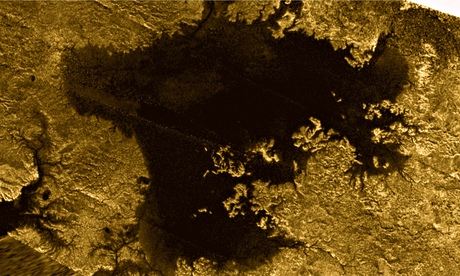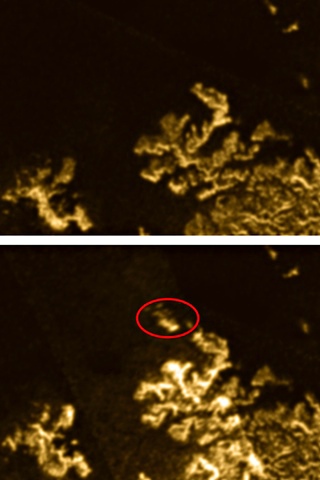“Magic Island” Appears And Disappears From Titan’s Lakes
This article is more than 2 years old
 A few months after the donut-shaped Mars rock made its mysterious appearance (which we now know was thanks to being moved around by Opportunity Rover), scientists are pondering another great, and bigger, cosmic mystery — an object described as a “magic island” that suddenly appeared and then disappeared from one of Titan’s lakes.
A few months after the donut-shaped Mars rock made its mysterious appearance (which we now know was thanks to being moved around by Opportunity Rover), scientists are pondering another great, and bigger, cosmic mystery — an object described as a “magic island” that suddenly appeared and then disappeared from one of Titan’s lakes.
NASA’s Cassini probe has been hanging out around Saturn’s largest moon for a while now, capturing image after remarkable image. Scientists examining those images found one that revealed a big object in the middle of one of Titan’s biggest bodies of water, Ligeia Mare, which is nearly 500 feet deep. Cassini snapped images of the sea in 2007, 2009, and 2013, and an image from July 10, 2013 shows a mysterious white blob, which scientists are calling the “magic island” until they know more. The island is approximately six miles wide and 12 miles long, and it doesn’t appear in images captured just two weeks later.

Current theories to explain the mass include the possibility that bubbles surfaced from something underwater, that some material such as heavy hydrocarbons is hanging out just under the surface, that something prompted wave action (despite none having been previously observed there before), or that an iceberg separated from the icy shores. The northern hemisphere of Titan is warming up as summer approaches (it will be in full swing by 2017), which may be having enough of an effect on the lake to generate such an image. Planetary scientist Jason Hofgartner says, “We can’t be sure what it is yet because we only have the one image, but it’s not something you would normally see on Titan.”
But Titan is a mecca for all kinds of weird stuff. Other than Earth, it’s the only place we know of to have stable oceans of water on its surface, as well as rainfall. Those bodies of water are comprised of methane and ethane, and Titan’s polar lakes contain “hundreds of times more natural gas and other liquid hydrocarbons than all the known oil and natural gas reserves on Earth,” according to NASA scientists. Those hydrocarbon seas are about -180C.
Scientists will continue monitoring and studying the area, and some have toyed with the idea of sending some kind of floating sea craft to the moon for up-close study. NASA has even discussed sending a balloon and rover to Titan. Whatever the explanation for the magic island is, one thing we know for sure is that it’s far from the last mystery Titan will provide.












